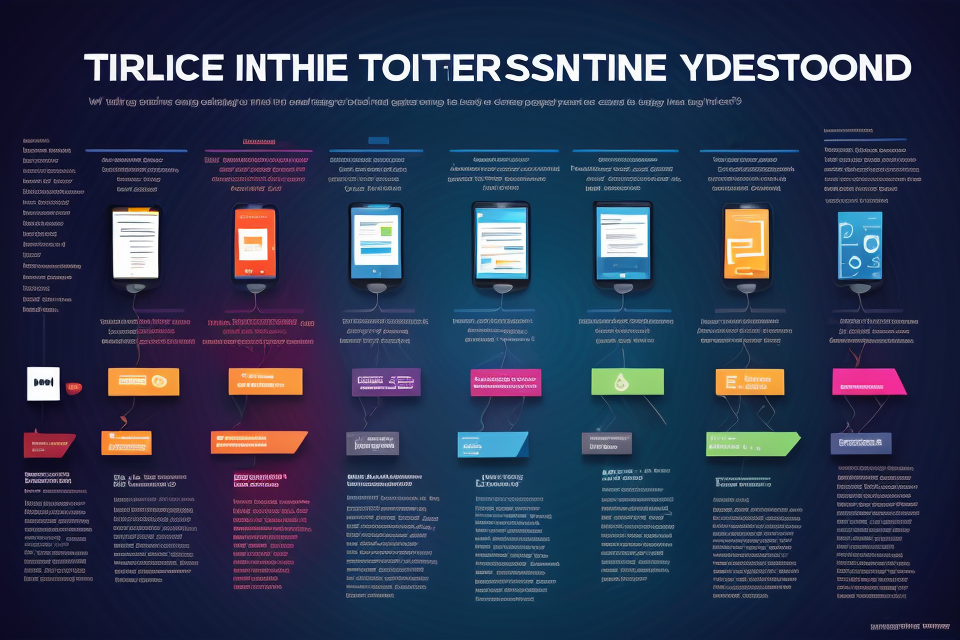The Internet has become an integral part of our lives, but when did it first become accessible to the public? The history of the Internet is a fascinating tale of innovation, collaboration, and determination. It’s hard to believe that the global network we know today began as a small project funded by the US government. In this article, we’ll take a comprehensive look at the history of the Internet and explore the events that led to its public launch. So, let’s journey back in time and discover when the Internet first became available to the masses.
The Early Days of the Internet
ARPANET and the Birth of the Internet
The origins of the Internet can be traced back to the 1960s when the United States Department of Defense launched a project called ARPANET. ARPANET was a network of computers that were used for research and communication purposes. It was designed to enable the sharing of resources and information among various institutions, including universities and research centers.
The first message ever sent over ARPANET was “LO,” which was short for “login.” This simple message marked the beginning of a revolution in communication that would change the world forever. The ARPANET system was designed to be fault-tolerant, meaning that it could continue to function even if some of its components failed. This was an important feature that allowed the network to grow and expand over time.
The first node of ARPANET was created at the University of California, Los Angeles (UCLA), and the second node was created at the Stanford Research Institute (SRI). These two nodes were connected by a telephone line, and the first successful message transfer was completed in October 1969. The message consisted of the words “login” and “goto,” which were sent from UCLA to SRI.
Over time, more and more institutions joined the ARPANET network, and the system began to take on a more recognizable form. The first email was sent in 1971, and the first viruses were detected in the early 1980s. The Internet continued to grow and evolve over the next several decades, eventually becoming the global network that we know today.
The Evolution of the Internet
- In the early days of the Internet, the first email system was created in the 1970s, which was simply called “email.” This allowed for the transmission of messages between computers, revolutionizing the way people communicated.
- The 1980s saw the rise of the World Wide Web, which was created by Tim Berners-Lee and marked a significant turning point in the history of the Internet. The World Wide Web enabled the creation of hypertext documents, which could be accessed and shared by anyone with an Internet connection.
- In the 1990s, the Internet became more accessible to the general public with the advent of dial-up Internet service providers. This allowed people to access the Internet from their homes and made it possible for businesses to establish an online presence.
Overall, the evolution of the Internet was a gradual process that occurred over several decades. Each new development brought about significant changes and paved the way for further innovation.
The Public Launch of the Internet
The World Wide Web Goes Public
In 1989, the World Wide Web was created by Tim Berners-Lee, a British computer scientist. Berners-Lee envisioned a system that would allow people to easily access and share information over the internet. He developed the first website, “Info.Cern.Ch,” in 1991, which provided an introduction to the World Wide Web and its capabilities.
However, it wasn’t until 1993 that the World Wide Web became more accessible to the general public with the release of the first web browser, Mosaic. Mosaic was the first browser to display images alongside text, making it easier for people to navigate and understand the content on the web.
This release marked a significant turning point in the history of the internet, as it allowed for the creation and sharing of multimedia content, which led to the rapid growth of the World Wide Web. With the release of Mosaic, the World Wide Web went public, and the internet began to transform into the global information network that it is today.
The Commercialization of the Internet
The late 1990s marked a significant turning point in the history of the internet as commercial interests began to play a more prominent role. Companies such as Amazon and eBay led the way in transforming the internet from a purely academic and research tool into a platform for business and commerce.
One of the key drivers of this shift was the emergence of e-commerce, which allowed businesses to reach a global audience through the internet. Amazon, for example, revolutionized the way people shopped by offering a wide range of products at competitive prices, delivered right to their doorstep.
The late 1990s also saw the emergence of new technologies that facilitated the growth of e-commerce. For example, the widespread adoption of secure socket layer (SSL) encryption technology made it safer for people to enter sensitive information such as credit card numbers when making online purchases.
In addition to e-commerce, the late 1990s saw the emergence of new business models such as advertising-supported content and subscription-based services. Companies like Google, which launched in 1998, revolutionized the search engine industry by introducing a new advertising-supported model that allowed users to search for information for free while generating revenue through targeted advertising.
Another notable development during this period was the launch of the first social media platform, Six Degrees, in 1999. This platform allowed users to create profiles, connect with friends, and share information with one another, marking the beginning of the social media era.
Overall, the commercialization of the internet in the late 1990s marked a significant turning point in its history, transforming it from a purely academic and research tool into a platform for business, commerce, and social interaction.
The Internet Today
The Impact of the Internet on Society
- The Internet has revolutionized the way we communicate, work, and access information, leading to significant changes in society.
- Social media platforms have transformed the way we interact with each other, allowing for more diverse and inclusive conversations.
- Marginalized communities have gained a voice and a platform to share their stories and connect with others.
- The Internet has also had a profound impact on the economy, with e-commerce and online advertising becoming major industries.
- E-commerce has made it easier for small businesses to reach a global audience and has created new opportunities for entrepreneurs.
- Online advertising has transformed the way companies market their products and services, making it possible to target specific audiences with tailored messages.
- However, the Internet has also created new challenges, such as cyberbullying, online harassment, and the spread of misinformation.
- These issues have raised concerns about privacy, security, and the ethical use of technology.
- Despite these challenges, the Internet continues to shape and influence society in ways that are both positive and negative.
The Future of the Internet
- The Internet is constantly evolving, with new technologies and platforms emerging all the time.
- One example of this is the growth of social media, which has changed the way people communicate and share information.
- Another example is the rise of e-commerce, which has transformed the way people shop and do business.
- The Internet of Things (IoT) is a new development that is transforming the way we interact with the world around us.
- IoT refers to the network of physical devices, vehicles, home appliances, and other items embedded with electronics, software, sensors, and connectivity which enables these objects to connect and exchange data.
- Examples of IoT devices include smart thermostats, smart light bulbs, and smart home security systems.
- Augmented reality and virtual reality are also becoming more prevalent, offering new ways for people to experience the world.
- Augmented reality (AR) is a technology that superimposes digital information on the real world, allowing users to see and interact with virtual objects in their environment.
- Virtual reality (VR) is a technology that creates a completely immersive digital environment, allowing users to experience a different reality.
- Examples of AR and VR applications include gaming, education, and entertainment.
As the Internet continues to evolve, it is likely that we will see even more innovative technologies and platforms emerge. It is an exciting time for the Internet, and it will be interesting to see where it goes next.
The Importance of Internet Safety
Protecting Personal Information
As we spend more time online, it is important to be mindful of the personal information we share. This includes sensitive information such as our names, addresses, and financial information. It is important to be cautious when sharing this information online and to only do so with trusted sources.
Being Mindful of Online Scams and Frauds
The Internet has also become a breeding ground for scams and frauds. It is important to be aware of these tactics and to be cautious when clicking on links or providing personal information. This includes being wary of emails or messages that ask for personal information, as well as online offers that seem too good to be true.
Being Respectful of Others Online
Finally, it is important to be respectful of others online. This includes avoiding cyberbullying and harassment, as well as being mindful of the impact of our online actions on others. It is important to remember that the Internet is a public space and that our actions online can have real-world consequences.
Staying Informed and Taking Steps to Protect Ourselves
To ensure our safety online, it is important to stay informed about Internet safety issues and to take steps to protect ourselves and our communities. This includes using strong passwords, keeping our software up to date, and being cautious when using public Wi-Fi. It is also important to be aware of the resources available to us, such as online privacy tools and Internet safety guides. By taking these steps, we can help to ensure that we use the Internet safely and responsibly.
FAQs
1. What year did the Internet go public?
The Internet went public in 1969 with the creation of the first official protocol, ARPANET. This was the first time that computers could communicate with each other over a network, and marked the beginning of the modern Internet.
2. How did the Internet go public?
The Internet went public through the development of the ARPANET project, which was funded by the United States government and led by Vint Cerf and Bob Kahn. The first official protocol, known as the “Host-to-Host Protocol,” was created in 1969 and allowed computers to communicate with each other over a network for the first time.
3. Who was involved in the creation of the Internet?
The creation of the Internet was led by Vint Cerf and Bob Kahn, who were contracted by the United States government to develop the ARPANET project. The project was funded by the government and involved numerous universities and research institutions.
4. How has the Internet evolved since it went public?
Since it went public in 1969, the Internet has undergone significant evolution and growth. It has expanded to include a vast network of computers and servers, and has become an essential part of modern life. It has also given rise to new technologies and industries, such as e-commerce and social media.
5. What was the first website ever created?
The first website ever created was called “Information on the Internet,” and was created by Tim Berners-Lee in 1991. It was a simple page that explained the basics of the World Wide Web, which he had also invented.
Would you rather your internet search history go public, or a s*x tape that goes viral?
https://www.youtube.com/watch?v=7zJWMNeg7IY



